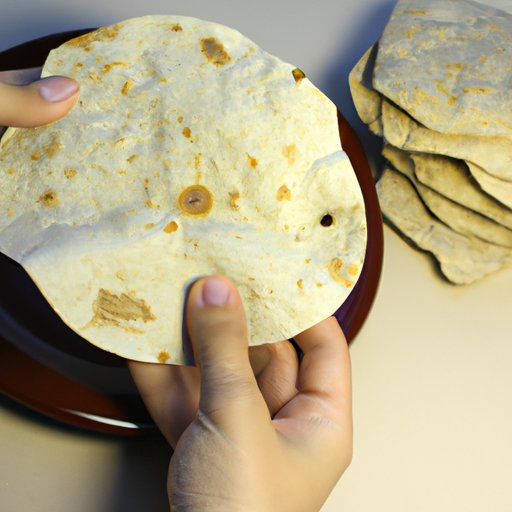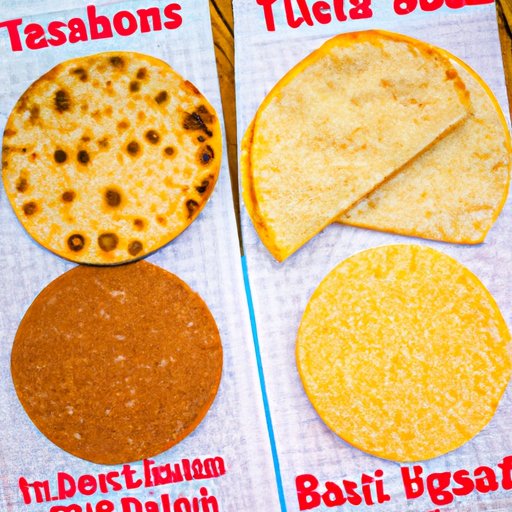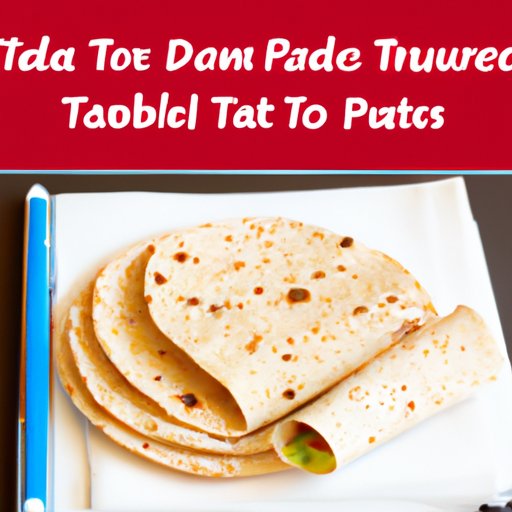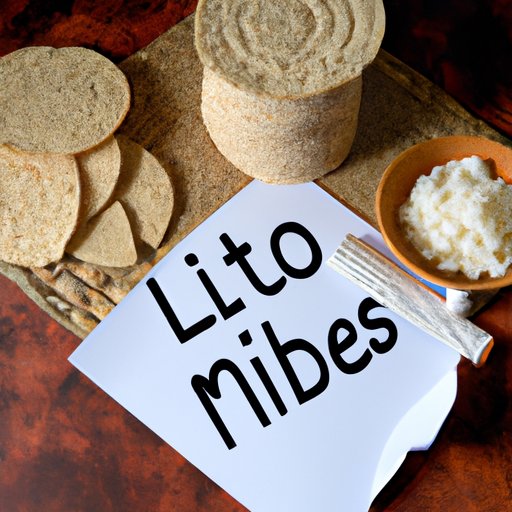Introduction
Diabetes is a chronic condition that affects millions of people worldwide. It is caused by an inability to produce or respond to insulin, which can lead to high blood sugar levels. People with diabetes must adhere to a special dietary plan in order to manage their condition properly. This often means avoiding certain foods and drinks and eating a balanced diet full of nutritious foods.
Tortillas are one type of food that many diabetics wonder about. Can they be included in a diabetic meal plan? This article will explore the nutritional value of different types of tortillas and how they can fit into a diabetic diet. We will also provide tips for incorporating tortillas into meal plans and delicious recipes that are both nutritious and tasty.

Exploring How Tortillas Fit into a Diabetic Diet
Tortillas come in many forms, from corn to flour to whole wheat. Each type has its own nutritional value and can provide different health benefits. Let’s take a look at the nutritional value of some common types of tortillas.
Nutritional Value of Different Types of Tortillas
Corn tortillas are made from ground corn and are usually low in fat and calories. They are also a good source of fiber, vitamins, and minerals. One 6-inch corn tortilla contains approximately 70 calories, 1 gram of fat, 17 grams of carbohydrates, 2 grams of protein, and 2 grams of dietary fiber.
Flour tortillas are made from wheat flour and are higher in calories than corn tortillas. They contain more carbohydrates and fat, but they are still a good source of fiber. One 6-inch flour tortilla contains approximately 110 calories, 4 grams of fat, 18 grams of carbohydrates, 3 grams of protein, and 2 grams of dietary fiber.
Whole wheat tortillas are made from whole wheat flour and are higher in fiber than other types of tortillas. They are also higher in calories and fat but still a good source of vitamins and minerals. One 6-inch whole wheat tortilla contains approximately 120 calories, 5 grams of fat, 21 grams of carbohydrates, 5 grams of protein, and 4 grams of dietary fiber.
Glycemic Index of Various Tortilla Products
The glycemic index (GI) is a measure of how quickly a food increases blood sugar levels. Foods with a high GI are absorbed quickly, causing a rapid spike in blood sugar. Foods with a low GI are absorbed more slowly, resulting in a gradual increase in blood sugar. Corn and flour tortillas have a moderate GI, while whole wheat tortillas have a low GI.
Understanding the Nutritional Value of Tortillas for Diabetics
When it comes to understanding the nutritional value of tortillas for diabetics, it’s important to consider the carbohydrates, proteins, and fats they contain. It’s also important to look at the fiber content and the vitamins and minerals they provide.
Carbohydrates, Proteins, and Fats in Tortillas
Tortillas are mainly composed of carbohydrates, with a small amount of protein and fat. The carbohydrates in tortillas are mainly starches, which break down into simple sugars during digestion. These sugars are then absorbed into the bloodstream, raising blood sugar levels.
Proteins and fats are also present in tortillas, though in smaller amounts. Both of these macronutrients can help slow down the absorption of carbohydrates, preventing a rapid spike in blood sugar.
Fiber Content
Fiber is an important nutrient for diabetics, as it helps slow down the absorption of carbohydrates and prevents rapid spikes in blood sugar. Whole wheat tortillas are higher in fiber than corn or flour tortillas, making them a better choice for diabetics.
Vitamins and Minerals
Tortillas provide a variety of vitamins and minerals, including iron, zinc, magnesium, and B vitamins. These nutrients are essential for overall health and can help support a healthy immune system and metabolism.

Comparing Types of Tortillas and Their Effect on Blood Sugar Levels
Different types of tortillas can have different effects on blood sugar levels. Here is a comparison of the three main types of tortillas and their effect on blood sugar:
Corn Tortillas
Corn tortillas are lower in calories and fat than other types of tortillas, making them a better choice for diabetics. They also have a moderate GI, meaning they won’t cause a rapid spike in blood sugar.
Flour Tortillas
Flour tortillas are higher in calories and fat than corn tortillas, but they still have a moderate GI. They may cause a slight spike in blood sugar, but not as much as other types of tortillas.
Whole Wheat Tortillas
Whole wheat tortillas are higher in fiber than other types of tortillas, making them a good choice for diabetics. They have a low GI, so they won’t cause a rapid spike in blood sugar.

Tips for Incorporating Tortillas into a Diabetic Meal Plan
Incorporating tortillas into a diabetic meal plan is possible, but there are some tips to keep in mind. Here are a few tips for incorporating tortillas into a diabetic meal plan:
Limiting Portion Sizes
Tortillas are high in carbohydrates, so it’s important to limit portion sizes when eating them. A good rule of thumb is to limit servings to one or two 6-inch tortillas per meal.
Making Healthy Substitutions
It’s important to make healthy substitutions when eating tortillas. For example, instead of using butter or margarine, use olive oil or avocado oil. Also, choose low-fat cheese and lean proteins such as chicken or fish.
Checking Labels for Unhealthy Additives
When buying tortillas, it’s important to check the labels for unhealthy additives such as added sugars or trans fats. These additives can increase blood sugar levels and should be avoided.
Creating Delicious Recipes with Tortillas for Diabetics
Tortillas can be used to create delicious and nutritious meals for diabetics. Here are a few recipes that are both tasty and healthy:
Breakfast Burritos
Start by heating a 6-inch corn tortilla in a skillet over medium heat. Add scrambled eggs, black beans, diced tomatoes, and shredded cheese. Fold the tortilla in half and cook until the cheese is melted. Serve with a side of fresh fruit or a smoothie.
Baked Enchiladas
Preheat oven to 375°F. Spread a layer of enchilada sauce in the bottom of a baking dish. Fill 6-inch corn tortillas with cooked chicken, black beans, and shredded cheese. Roll up the tortillas and place them in the baking dish. Top with more enchilada sauce and cheese. Bake for 25 minutes. Serve with a side of steamed vegetables.
Quesadillas
Heat a 6-inch whole wheat tortilla in a skillet over medium heat. Add cooked chicken, black beans, diced tomatoes, and shredded cheese. Fold the tortilla in half and cook until the cheese is melted. Cut into wedges and serve with a side of guacamole and salsa.
Conclusion
Tortillas can be part of a healthy and balanced meal plan for diabetics. They are a good source of fiber, vitamins, and minerals and can help slow down the absorption of carbohydrates. When choosing tortillas, opt for whole wheat varieties, which are higher in fiber and have a lower GI. It’s also important to watch portion sizes and make healthy substitutions when eating tortillas. With a bit of creativity, you can create delicious recipes that are both nutritious and tasty.
In conclusion, eating tortillas as a diabetic can be part of a healthy and balanced diet. Just be sure to pay attention to portion sizes and choose whole wheat varieties whenever possible. With a little planning and creativity, you can enjoy delicious and nutritious recipes that are perfect for diabetics.
(Note: Is this article not meeting your expectations? Do you have knowledge or insights to share? Unlock new opportunities and expand your reach by joining our authors team. Click Registration to join us and share your expertise with our readers.)
